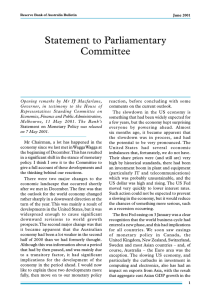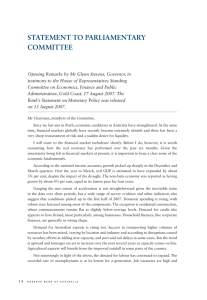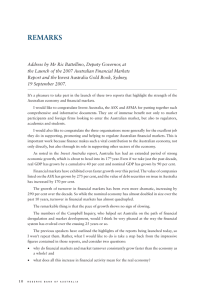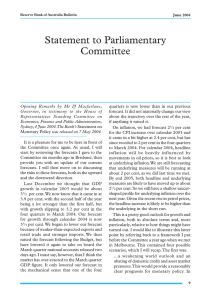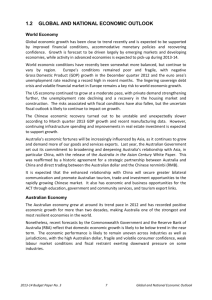Economic Conditions and Prospects
advertisement
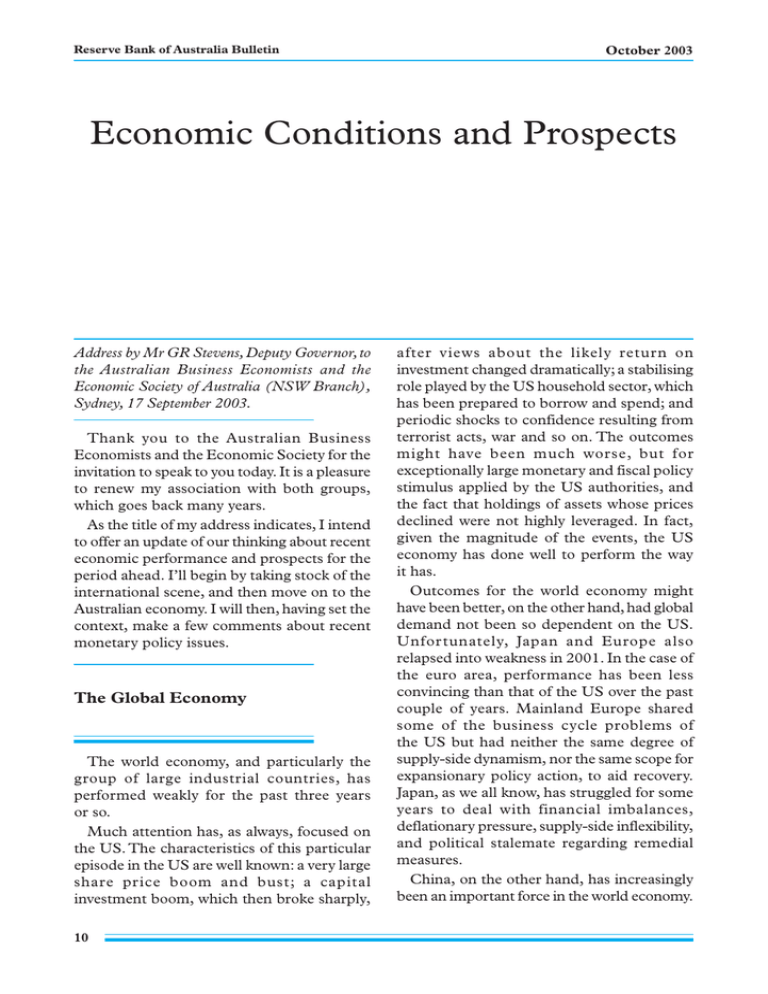
Reserve of Australia Bulletin Economic Bank Conditions and Prospects October 2003 Economic Conditions and Prospects Address by Mr GR Stevens, Deputy Governor, to the Australian Business Economists and the Economic Society of Australia (NSW Branch), Sydney, 17 September 2003. Thank you to the Australian Business Economists and the Economic Society for the invitation to speak to you today. It is a pleasure to renew my association with both groups, which goes back many years. As the title of my address indicates, I intend to offer an update of our thinking about recent economic performance and prospects for the period ahead. I’ll begin by taking stock of the international scene, and then move on to the Australian economy. I will then, having set the context, make a few comments about recent monetary policy issues. The Global Economy The world economy, and particularly the group of large industrial countries, has performed weakly for the past three years or so. Much attention has, as always, focused on the US. The characteristics of this particular episode in the US are well known: a very large share price boom and bust; a capital investment boom, which then broke sharply, 10 after views about the likely return on investment changed dramatically; a stabilising role played by the US household sector, which has been prepared to borrow and spend; and periodic shocks to confidence resulting from terrorist acts, war and so on. The outcomes might have been much worse, but for exceptionally large monetary and fiscal policy stimulus applied by the US authorities, and the fact that holdings of assets whose prices declined were not highly leveraged. In fact, given the magnitude of the events, the US economy has done well to perform the way it has. Outcomes for the world economy might have been better, on the other hand, had global demand not been so dependent on the US. Unfor tunately, Japan and Europe also relapsed into weakness in 2001. In the case of the euro area, performance has been less convincing than that of the US over the past couple of years. Mainland Europe shared some of the business cycle problems of the US but had neither the same degree of supply-side dynamism, nor the same scope for expansionary policy action, to aid recovery. Japan, as we all know, has struggled for some years to deal with financial imbalances, deflationary pressure, supply-side inflexibility, and political stalemate regarding remedial measures. China, on the other hand, has increasingly been an important force in the world economy. Reserve Bank of Australia Bulletin It is probably reaching the point of equality with Japan, about now, in terms of its size in international trade. China’s growing economic importance is evident in the data, and also in the way in which the renminbi exchange rate is becoming an important political issue – just like the yen. Against that general backdrop, assessments of the near-term outlook for the global economy have undergone some important changes over the past eighteen months. Through the first half of 2002, indications of strengthening growth saw hopes rising for better times, only to be disappointed in the second half of the year. Activity remained sluggish and confidence took a hit from the aftershocks of the bubble, in the form of, inter alia, accounting and governance scandals (that is, some of the sorts of things which emerge after every period of excess). During the first half of 2003, growth and confidence were still at a rather low ebb. Things which did not help confidence were the anticipation of war in Iraq, and the associated rise in oil prices. The outbreak of SARS was also very damaging to a part of the international business scene still struggling with the effects of earlier shocks. Then there was the spectre of deflation. It’s understandable that this would be a concern, since inflation rates were already below zero in a few countries, and low to very low in most others. A period of below-par growth was likely, if anything, to push inflation down further. My own views about the way we should think about deflation were given nearly a year ago. I thought that it was possible that a few more countries could experience deflation briefly, but that the likelihood of widespread, protracted and corrosive deflation was low, at least absent a significant policy error. Nonetheless, since prudent central banks operate on the logic of least regret, some of them had to give attention to the issue, just in case, and they did so during the past nine months. The US Federal Reser ve, in October 2003 particular, made it clear that it wanted to err on the side of ease, since even a low probability of inflation falling ‘too far’ was something to be resisted, and openly discussed measures that could be employed were interest rates to reach the zero lower bound. The Iraq war was over quickly and its direct economic effects have been expansionary for the US economy in recent months.1 But all these accumulated worries affected perceptions of the outlook through to mid year. The clearest indication of this was that bond markets pushed down yields to levels not seen in decades. There were some special factors in operation but, even allowing for those, the tone of bond markets in May and June can only be described as particularly pessimistic. There also seemed to be some uncertainty, even if only briefly, about the US Administration’s intentions for the US dollar. Given the rapid rise against the US dollar of the Australian dollar during that period, this caught our attention. There was a period, in other words, when it was not that hard to imagine a rather nasty international outcome – one where the fear of deflation in the US and elsewhere, regardless of how well based it was, could affect behaviour, and where the US dollar could be moving rapidly downwards, exporting any deflation pressure to other countries, including Australia. While the probability of this scenario was still not that high, it seemed to be increasing, to the point where it caused us some discomfort. Readers of the Governor’s 6 June remarks to the House Economics Committee could see quite clearly the degree of concern at that time. We can all feel some genuine relief that things have looked better since. After a weak early part of the year, the US economy is doing much better in the second half. SARS had a big, but temporary, impact in east Asia, but relatively little impact elsewhere. East Asia is now recovering quickly from that. China continues to grow rapidly. The US economy, 1. The bigger issue has always been, and remains, the nature of the peace. This will probably cost more than the war and presumably adds to uncertainty about the medium-term economic outlook, but seems not to affect short-run perceptions in the same way as actual conflict. 11 October 2003 Economic Conditions and Prospects while experiencing very low inflation, has not slipped into deflation, and some countries which have experienced deflation seem to be experiencing a bit less of it now (e.g. China). Japan has, I think it is fair to say, surprised most people with solid growth over recent quarters. The euro area remains the weakest of the major regions, although there are tentative signs of improving conditions there in some of the most recent survey data. For the first time in a while, consensus forecasts for world growth are edging higher, not lower. Financial market pricing also clearly has retreated from the pessimism in May and June: the exceptionally low bond rates have risen to being simply quite low. Share markets had already turned somewhat more optimistic earlier, and have remained so. While we could argue about the extent to which future profits growth in the US is required to validate current pricing, what seems in little doubt is that actual profits in the US have recovered quite strongly to date. That is testimony to the capacity of the US corporate sector to respond aggressively to problems, which is ultimately a source of dynamism for the US economy. Finally, after a very strong upward trend earlier in the year, the Australian dollar has traded fairly steadily in recent times. None of this is to say that the world economy is completely out of danger. Things could still go wrong while ongoing adjustments continue. There could be new shocks. Or the US expansion might wane if the growth in demand and output does not find some reflection in higher employment, thus starving the system of some of the fuel for further expansion in demand. Even if things are proceeding well, we will inevitably see the odd patch of weak data. Once the danger of excessive near-ter m weakness is past, moreover, there will be issues to address – like the long-term trend in government finances in a number of countries. But these sorts of caveats apply in every cycle, to some degree. The fact remains that things look better than they did three or four months ago, and noticeably better than we feared, at that time, they might look by now. That we are now talking about whether the 12 pick-up extends into 2004, rather than whether it is occurring at all, is welcome progress. The Australian Economy The Australian economy has been significantly affected by the weakness in the world scene over the past few years. This is most evident in the trends in exports. In the June quarter of 2003, aggregate export volumes were about 2 per cent lower than in the middle of 2000 (just before the Olympics spike). This is a series which in the 1990s grew at an average rate of 71/2 per cent per year. If that is a crude gauge of ‘normal’ performance, there was an export volume shortfall of over 20 per cent by the middle of this year. That’s over 5 per cent of GDP, which is a much more substantial effect than seen in the Asian crisis. Why was the effect bigger on this occasion, even though the Asian crisis had a bigger impact on the growth rates of our particular trading-partner group? The answer is mainly, I think, because the Asian crisis was a regional problem which occurred against a backdrop of strength elsewhere (as we now know, but didn’t at the time). So many of Australia’s exporters could find other markets. That is obviously harder to do when the problem lies with the global economy. In addition, of course, there was the effect of the drought on rural exports, and of the events of September 11 2001 and SARS on exports of tourism services, which were over and above the normal effects of global weakness. How has the economy handled the loss of income? In a world of open capital markets, one would expect that a temporary reduction in income would in part be reflected in slower growth of spending, but in part also in a temporary change in our saving behaviour – saving less of our own income, drawing more on the saving of others. That is, we smooth our living standards in the face of swings in income. This behaviour means that there is some slowing in GDP growth, but much less Reserve Bank of Australia Bulletin than would be the case, were our spending behaviour to be confined to following much more closely the reduction in income. At the same time, as we all know, a longterm adjustment has been under way in the structure of households’ balance sheets, which has been tending to elevate spending relative to income for some time. It so happens that the direction of this effect has, in the past couple of years, suited what was needed to adapt to the international conjunctural circumstances. We can’t distinguish from the data what was the result of this structural change and what was due to a cyclical response to a particular income shock. But the broad effects of the combined forces are fairly clear in the national income accounts. We have seen domestic final demand rise by over 41/2 per cent over the past year – to be sure, more moderate than the 6–7 per cent pace it was recording a while back, but still faster than average. Real net exports fell by 31/2 per cent of GDP over the latest year, influenced by the world economy and the drought. Between them, those two factors did most of the work pegging GDP growth back to a below-average 2 per cent over the year. Over the same period, the current account deficit has increased by about 3 per cent of GDP. This is smaller than the decline in real net trade volumes because Australia’s terms of trade have continued to improve over the past year – by nearly 3 per cent, which is worth about 1/2 per cent of GDP in additional income. So the Australian community, by having access to capital markets, and facing macroeconomic policy settings which remained on the expansionary side, was able to continue to increase its spending at a very strong pace, even though income growth was impaired by international events. This involved declining rates of saving out of current income, and some extraction of accumulated equity from the dwelling stock. Generally speaking, to have that flexibility is a good thing – with the proviso that, as with all good things, we don’t want to over-indulge. October 2003 We can anticipate that, over the coming year, the two factors weakening overall performance over the past year will not recur, and indeed some reversal of these effects is likely. It is widely acknowledged now that there will be a strong recovery in farm production. The prospect of some continuing improvement in international conditions means that the downward trend in non-farm exports should bottom out, and a recovery begin. At the same time, domestic demand growth should moderate a little. Capital spending by firms will probably continue to rise, but not as quickly, on current indications, as it has over the past year. Some decline in dwelling construction activity has occurred, although this looks smaller than earlier thought. Consumption spending looks likely in the near term to continue to benefit from steady growth in incomes, high levels of confidence and the higher and more accessible wealth available to households. If this outlook is correct, growth in the economy has probably already slowed as much as it is likely to. The year-ended growth rate of non-farm GDP will decline for another quarter as an earlier very strong quarter drops out. But the pace of expansion through the second half of 2003 is probably going to be at least as good as it was in the first. If the global economy continues on its present track, Australian growth should clearly be picking up by the first half of next year. Inflation will be pushed down a bit by the earlier exchange rate appreciation for a while, but is still thought likely to be about 21/2 per cent in the medium term, based on the usual assumptions about oil prices, exchange rates and interest rates, and the above growth outlook. This picture is much as was described in our Statement on Monetar y Policy on 11 August. Since that document was published, it is fair to say that the downside risks to the global economy have retreated further. Most recent data on the Australian economy also seem consistent with a moderation in non-farm growth in the first half of the year, but suggest that it has neither been particularly pronounced, nor showed signs of being long-lived. 13 Economic Conditions and Prospects Risks and Policy Considerations It has become much better understood in recent years that once a coherent framework for monetary policy is in place, the regular policy decision is essentially a matter of responding to the changing balance of risks to the outlook. The RBA’s Board certainly has had a busy time over the past year or more evaluating and deciding how to respond to the evolving balance of international and domestic risks. It takes a lot more work than you might think to leave rates unchanged for fifteen consecutive months! In the middle of last year, it looked as though the international economy was returning to stronger conditions, and Australian domestic demand was growing very strongly indeed. To foster an inflation outcome consistent with our medium-term target, we believed that it would be prudent under such conditions to return interest rates to normal, or ‘neutral’, from a relatively expansionary setting. Two initial steps were taken, and the likelihood of further steps clearly signalled. But in the event, the process did not continue, because the world economy began turning out differently to what we had assumed. By the end of 2002, it was clear that any thought of near-term tightening could go off the agenda for a while. The world economy had clearly lost some momentum, and for the time being, this meant that a steady interest rate structure would probably be associated with achieving our policy objectives. That remained the story through to the middle of 2003, as the Iraq war came and went, most international data looked on the soft side, the drought continued, and financial market sentiment waxed and waned. The outlook for Australia was for moderate growth – quite a good outcome in the circumstances – but our feeling was that the risks stemming from inter national developments were tilted to the downside. Inflation, if anything, looked a little higher than had been expected, although our 14 October 2003 judgement was that in the medium term, it would still turn out to be consistent with the target. That was a macroeconomic outlook which certainly did not, in my view at least, amount to an obvious case for monetary policy to be noticeably easier than was already in place. A reasonable case could be made that policy should be easier than neutral – but it already was, and had been for some time. Our conviction that the level of interest rates was exer ting stimulus to the economy – a conviction strengthened when we looked at the demand for credit and the behaviour of asset markets – and a view that the inflationtargeting framework does not call for trying to fine-tune outcomes, have both been important in policy deliberations. At the same time, it should be obvious that the shifting assessment of the balance of risks to the outlook (which can occur without there necessarily being major changes to central forecasts) has also been critical. When, after a period of disappointing international outcomes in the first half of 2003, the external threats to the economic outlook seemed suddenly to be building up rather dangerously through May and early June, it looked like a case to ease policy was building. Throughout this period, the situation was complicated by another type of risk. While views about the international situation were changing, at home the demand for credit from households, far from diminishing, seemed to be strengthening. Apart from the fact that this meant that the near-term outlook for domestic demand might well be stronger than assumed, the Bank had an obligation to consider the medium-term soundness of the economy in addition to the short-run conjuncture. There is no doubt that the preparedness of households to borrow has been imparting some strength to demand and general buoyancy to the economy and asset markets, and that this has been helpful in supporting growth in the circumstances of the past couple of years. But there cannot be much doubt either that running up debt today must diminish the scope to do so in future, and that it must also impair, at the margin, the capacity Reserve Bank of Australia Bulletin of some households to cope with adverse shocks which might come along. There are times when the above is a risk which just has to be incurred because another possible outcome is even worse. A disastrous international environment, coupled with a soaring exchange rate, would probably be one such time. That is why, in June, we publicly contemplated the possibility of easing. But we had to be fairly sure that the alternative was going to be pretty bad before we took action which we knew would be likely to inflame an asset market and borrowing boom. Monetary policy might not be able to do much to end an asset-price boom without a fair bit of collateral damage – so, at least, it is commonly claimed. But whatever one’s view on that, surely policy should avoid needlessly adding to the boom. ‘First, do no harm’ is a good motto here. We have sought to balance these various concerns over the past several months. Although in early June a case to ease looked like it was building, it had not strengthened sufficiently by the time of the July meeting to warrant action. In August the case got weaker, and it got weaker again by early September. Essentially what happened was that the risks to growth from abroad abated, while those posed by the rapid rise in debt did not. This recent experience, and the one a year earlier, is instructive in the discussion about central bank communication. What it shows is that, while it is natural for market participants and the media to want central banks to say more and more about their intentions, people need to keep very much in mind that our assessment of what we might need to do is, of necessity, highly conditional on a view of the future. And the future often turns up the unexpected – to which we need to respond by revising our intentions. So it is October 2003 important that observers not only listen to the central bank’s words, but also continue to look closely at the actual information coming in. I know the majority of you do. Secondly, because the future cannot be known, and because things can change quickly, people need some understanding of the principles which guide central bank behaviour. So there is probably more to be gained by continued efforts at articulating how our framework for policy works, than by providing ever more frequent commentary on events. Such information hopefully provides interested observers with a device to filter, in real time, the information becoming available. This, combined with a periodic account, after the event, of how we filtered it, is the most helpful form of transparency – describing how we think about things and, within that framework, why we did what we did.The most recent Statement on Monetary Policy, in fact, goes a good deal further down this track than most of its predecessors. Conclusion The world economy is still not entirely in the clear, but is better than it was, and a fair bit better than it might have been. It is sensible at present to look for further improvement, while keeping in mind the possibility of regression. If things work out acceptably well abroad, the Australian economy will next year have a better chance of balanced growth than we have had for a few years. We will continue to assess the evolving balance of risks and will respond, in a measured fashion, as needed – and we’ll do our best to keep you informed. R 15

